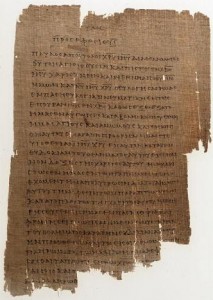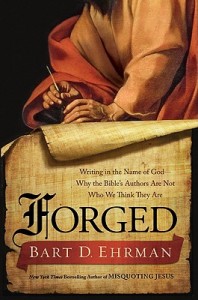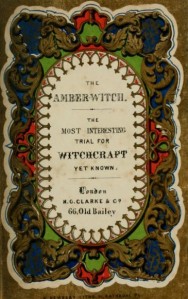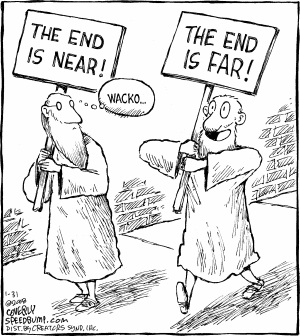 A popular view amongst skeptics is that Jesus was failed apocalyptic prophet. Their argument centers on the Olivet discourse in Mark 13:30 where Jesus says, “Truly, I say to you, this generation will not pass away until all these things take place.” They contend that this means Jesus predicted his return in power prior to the death of the disciples and that since this failed to happen, Jesus is proven a false prophet. Atheist websites galore use this as a proof text. Even a few serious scholars do as well. For instance, Bart Ehrman argues:
A popular view amongst skeptics is that Jesus was failed apocalyptic prophet. Their argument centers on the Olivet discourse in Mark 13:30 where Jesus says, “Truly, I say to you, this generation will not pass away until all these things take place.” They contend that this means Jesus predicted his return in power prior to the death of the disciples and that since this failed to happen, Jesus is proven a false prophet. Atheist websites galore use this as a proof text. Even a few serious scholars do as well. For instance, Bart Ehrman argues:
Jesus appears to have anticipated that the coming judgment of God, to be brought by the Son of Man in a cosmic act of destruction and salvation, was imminent. It could happen at any time. But it would certainly happen within his generation.[1]
Albert Schweitzer held a similar position:
At the end of His career Jesus establishes a connection between the Messianic conception, in its final transformation, and the Kingdom, which had retained its eschatological character; He goes to His death for the Messiahship in its new significance, but He goes on believing in His speedy return as the Son of Man.[2]
These are established scholars and we must take them seriously. However, are they really being honest with the data? More so, are they accounting for all of the data or merely pulling a verse from its context because it seems to infer an error on Jesus’ part.
I was listening to Gary Habermas’ lecture on the historical Jesus and an interesting question surfaced concerning Mark 13:32,
But concerning that day or that hour, no one knows, not even the angels in heaven, nor the Son, but only the Father (Mk 13:32).
Habermas uses this verse to demonstrate that Jesus’ messianic title “Son of Man” (cf. Dan 7:13) was not added later (no one would claim Jesus was God and then add a verse claiming he did not know something). Theologically, this verse is an embarrassing detail so it has an air of authenticity.[3] But more importantly, this verse appears directly after Jesus’ alleged prediction that he would return in his own generation. Doesn’t it seem odd that Jesus would predict his return within a very narrow time frame (his own generation) and then immediately say that he did not know when it would be? Actually, it seems incoherent for a reason. The skeptics have it wrong.
Jesus did not really teach that his return would be imminent. In fact, he provided hints it would not be. In Jesus’ parable about the ten talents, which is clearly about him leaving and then returning, he includes a pertinent detail, “Now after a long time the master of those servants came and settled accounts with them” (Mt 25:19). The parable of the Ten Virgins is another one which is centered on Jesus’ return and it provides a similar clue, “As the bridegroom was delayed, they all became drowsy and slept” (Mt 25:5). Craig Blomberg asks why Jesus would bother addressing so many worldly matters if he really believed as the critics suggest:
the majority of Jesus’ teaching presupposes a significant interval before the end of the world, because Christ spends much time instructing his disciples on such mundane matters as paying taxes, marriage and divorce, dealing with one’s enemies, stewardship of wealth, and so on.[4]
Jesus also implied an extended period of world evangelization, “And this gospel of the kingdom will be proclaimed throughout the whole world as a testimony to all nations, and then the end will come”( Mt 24:14). It seems absurd to argue that Jesus and the apostles would have expected world evangelization in their lifetime. This begs the question what did Jesus mean by this generation.
From the fig tree learn its lesson: as soon as its branch becomes tender and puts out its leaves, you know that summer is near. So also, when you see these things taking place, you know that he is near, at the very gates. Truly, I say to you, this generation will not pass away until all these things take place (Mk 13:28-30).
The “these things” of v. 30 must be the same as the “these things” of v. 29, which clearly refer to signs preceding Christ’s second coming. Jesus was teaching that the generation who witnessed the signs he had previously outlined in chapter 13 would see his return. There has been no other generation in history prior to our own that has seen these signs in such abundance.
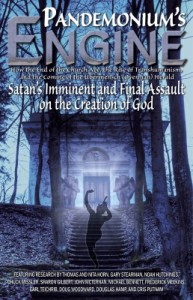 Get a signed copy of Pandemonium’s Engine here for $10.00
Get a signed copy of Pandemonium’s Engine here for $10.00
[1] Bart D. Ehrman, Jesus, Apocalyptic Prophet of the New Millennium (Oxford: Oxford University Press, USA, 1999),160.
[2] Albert Schweitzer, The Quest of the Historical Jesus (Joseph Kreifels).
[3] If you are interested in how Jesus can be God and not know something, the solution lies in his two natures human and divine. Look into the two minds view here.
[4] Craig Blomberg, in Michael J. Wilkins, Jesus Under Fire: Modern Scholarship Reinvents the Historical Jesus (Grand Rapids, Mich.: Zondervan, 1996), 31.


